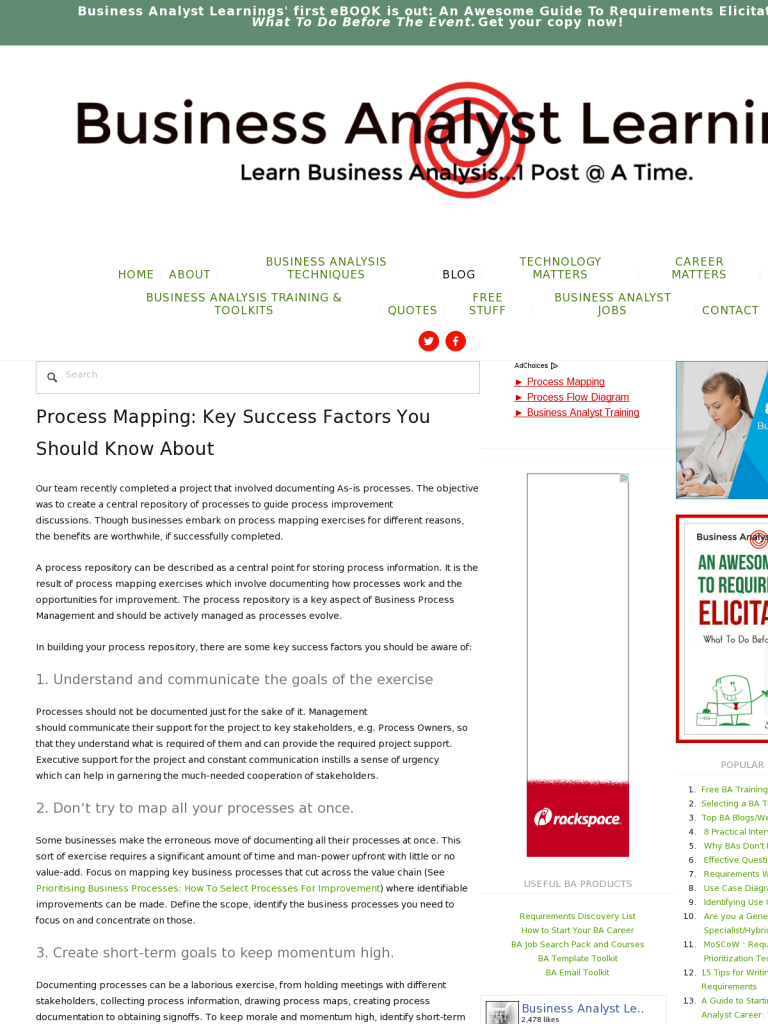Process Mapping: Key Success Factors You Should Know About
Blog: Business Analyst Learnings Blog
Our team recently completed a project that involved documenting As-is processes. The objective was to create a central repository of processes to guide process improvement discussions. Though businesses embark on process mapping exercises for different reasons, the benefits are worthwhile, if successfully completed.
A process repository can be described as a central point for storing process information. It is the result of process mapping exercises which involve documenting how processes work and the opportunities for improvement. The process repository is a key aspect of Business Process Management and should be actively managed as processes evolve.
In building your process repository, there are some key success factors you should be aware of:
1. Understand and communicate the goals of the exercise
Processes should not be documented just for the sake of it. Management should communicate their support for the project to key stakeholders, e.g. Process Owners, so that they understand what is required of them and can provide the required project support. Executive support for the project and constant communication instills a sense of urgency which can help in garnering the much-needed cooperation of stakeholders.
2. Don’t try to map all your processes at once.
Some businesses make the erroneous move of documenting all their processes at once. This sort of exercise requires a significant amount of time and man-power upfront with little or no value-add. Focus on mapping key business processes that cut across the value chain (See Prioritising Business Processes: How To Select Processes For Improvement) where identifiable improvements can be made. Define the scope, identify the business processes you need to focus on and concentrate on those.
3. Create short-term goals to keep momentum high.
Documenting processes can be a laborious exercise, from holding meetings with different stakeholders, collecting process information, drawing process maps, creating process documentation to obtaining signoffs. To keep morale and momentum high, identify short-term wins and milestones to keep team members from lagging behind or worse still, burning out.
4. Ensure that everyone understands the benefits of the exercise.
Closely related to understanding and communicating the goals of the exercise is ensuring that stakeholders know what they stand to gain and how the mapping exercise will deliver it. You must be able to connect the project to outcomes of business value. Stakeholders should be convinced that the output of the exercise will help them work smarter and better. Be clear on the benefits attainable by each stakeholder group and be willing to sell it to them.
5. The process mapping exercise should be done within a well-defined framework.
Identify the standards, templates and guidelines to be adopted for the exercise. The last thing you want is a process repository with multiple notation types for the same type of event or activity. It can easily become confusing for anyone reading the documents.
Business processes can be mapped to varying levels of abstraction. The purpose of the mapping exercise will of course, guide the process data you collect and the level of detail you go into. Agree on what levels of abstraction the process documentation exercise should cover. For example, will the mapping exercise cover all the processes within a function (e.g. Planning) with the ability to drill down to sub-processes and procedures?
6. Consider training team members
Not all team members will be equally versed in conducting the process mapping exercise. Set up a brief meeting/training session to bring everyone up to speed on what is expected of them. This training should cover the standards to be adopted, the tools to be used and any other unique requirements of the process mapping exercise (e.g. it may be necessary to capture the accounting transactions generated by each process step). Don’t assume everyone knows exactly what to do.
7. Identify and use an optimal process mapping tool
While tools like Visio and PowerPoint can be effective in the short-term for drawing process maps, a process repository tool is much better at managing process updates, version control and collaboration. Select and agree on the software tool that will best serve the needs of the business beyond the process mapping exercise. See Why Process Repositories Are Better Than Drawing Tools.
8. Reuse Process Map Elements
This will help save time. There’s no need to start from scratch every time you build a process map. Look for opportunities to reuse model elements wherever you can.
9. Get Sign-off
Getting your documents signed off will provide a reasonable degree of comfort to all that the information you have is correct. Though there are hassles that come with requesting for sign-off, it can help in identifying areas that need to be corrected or improved.
10. Focus on simplicity
There’s no benefit to building a repository that can only be understood by its architect. Using complex notations or wording can quickly become overwhelming for anyone reading the documents, thereby defeating the purpose of the exercise. With process mapping efforts, this popular saying rings true: Less is more.
These tips are also valid for As-is and To-be process documentation efforts.
Picture Attribution: “Success Concept” by tiramisustudio/freedigitalphotos.net
Leave a Comment
You must be logged in to post a comment.








